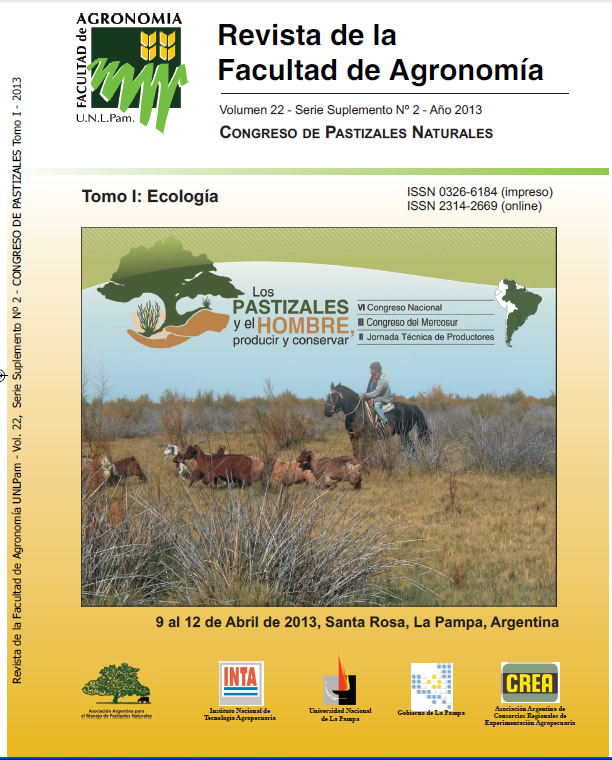Rearing beef heifers in natural grasslands – metaanalitical study of animal production
Keywords:
Multivariate analysis, Pampa Biome, Beef cattleAbstract
Irearing beef heifers in Rio Grande do Sul has been performed, mostly, in natural grasslands. This category has considerable nutrition requirements when mating at 24 monthswas proposed. This could need adjustment of grazing intensity to provide gains required for this category. The aim of this work was to characterize and to analyze possible relations not apparent, through of meta-analysis, with livestock data from nine experiments performed with heifers between seven and 26 months of age. Analyzed variables were carrying capacity(CC), average daily gain (ADG) and live weight gain per area (GPV). Data were transformed vectorially by standardizing by the range and submitted to multivariate analyzes of cluster and ordination using Euclidean distance as a measure of similarity. Cluster analyzes showed five groups of sampling units (p=0.02). ADG was the variable with highest correlation (R=0.98) with axis I, which explained most of data variation (64.27%). CC was the variable most correlated (R=0.98) with axis II, which explained 32.24% of results. The GPV was in the intermediate position it being 74.15% and 57.26% related to the axes I and II, respectively. From analyzed variables, ADG was the variable that explained most of data’s variability.
Downloads
References
Carvalho P.C.F., C. Nabinger, G. Lemaire & T.C.M. Genro. 2011. Challenges and opportunities for livestock production in natural pastures: the case of Brazilian Pampa Biome. In: Diverse rangelands for a sustainable society. International Rangeland Congress. Rosario, Argentina. pp. 9-15.
Lovatto P.A., C.R. Lehnen, I. Andretta, A.D. Carvalho & L. Hauschild. 2007. Metaanálise em pesquisas científicas - enfoque em metodologias. Rev. Bras. Zootec. 36(2): 285-294.
Pillar V.D. 2004. MULTIV, Multivariate Exploratory Analysis, Randomization Testing and Bootstrap Resampling. Departamento de Ecologia, UFRGS. Porto Alegre.
Quadros F.L.F., F.C. Garagorry, T.H.N. Carvalho, M.G. Rocha & J.P.P. Trindade. 2011. Utilizando a racionalidade de atributos morfogênicos para o pastoreio rotativo: experiência de manejo agroecológico em pastagens naturais do Bioma Pampa. Cadernos de Agroecologia. Rev. Bras. Agroecol. 6: 12716-127020.
Soares A.B., P.C.F. Carvalho, C. Nabinger, C. Semmelman, J.K Trindade, E. Guerra, T.S. Freitas, C.E. Pinto, J.A. Fontoura Júnior & A. Frizzo. 2005. Produção animal e de forragem em pastagem nativa submetida a distintas ofertas de forragem. Ciênc. Rural 35(5): 1148-1154
Downloads
Published
Issue
Section
License
La Editorial de la Universidad Nacional de La Pampa (EdUNLPam) exigirá a los/as autores/as la firma del siguiente documento:
La EdUNLPam lleva a cabo la publicación del artículo: (Título del Artículo) en SEMIÁRIDA Rev.Fac.Agron UNLPam ISSN 2362-4337 (impresa) ISSN 2408-4077 (en línea), del cual el/los abajo firmantes son autores de una o más partes. En el mismo acto, el/los autores entregan exclusivamente a la EdUNLPam todos sus derechos protegidos por las leyes de propiedad intelectual que rigen en la Argentina para reproducir, publicar, editar, fijar, comunicar y transmitir públicamente en cualquier formato o medio impreso o electrónico, inclusive internet, el artículo enviado a publicación e incluirlo en índices o bases de datos nacionales e internacionales. A cambio, la EdUNLPam entrega a los autores la autorización para la publicación o reimpresión con ines académicos y educativos en cualquier libro o medio de divulgación, con la sola obligación de citar el artículo original publicado en la EdUNLPam. Cada autor acuerda en que el material provisto a la EdUNLPam es un trabajo original, que no ha sido impreso o publicado en cualquier otro medio con anterioridad y que no vulnera derechos de terceros. El Primer autor tendrá la posibilidad de leer y corregir el artículo ya editado como “prueba de galera”, pero si el autor no devolviera esas correcciones de la prueba de galera dentro del tiempo especificado, el proceso de producción y publicación podrá proseguir sin la aprobación del autor. El/los autor/es no recibirán compensación monetaria de la EdUNLPam por el uso del material contenido en este artículo y asumen la responsabilidad de las opiniones vertidas en él.






.png)



22.png)



.jpg)




.jpg)
